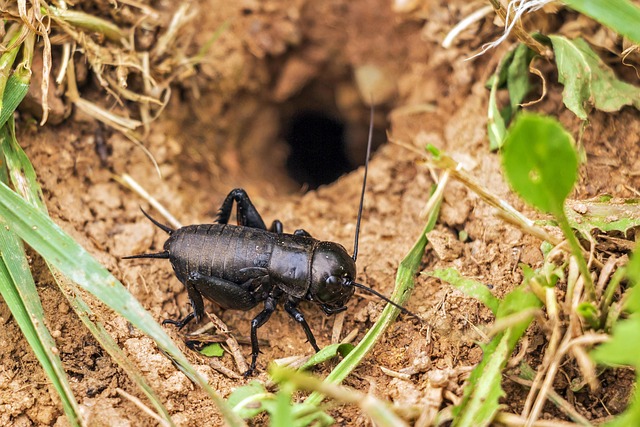Cricket infestations are a common residential and commercial nuisance, entering through cracks and hiding in suitable spaces. Prompt identification of entry points is crucial for effective cricket infestation treatment. Residential strategies include sealing points, removing food sources, using repellents, heat treatments, and targeted dusts. Commercial properties require specialized tailored strategies due to larger scale and high foot traffic. Long-term prevention involves regular inspections, sealing gaps, maintaining sanitation, and structured yard care regimens.
Cricket infestations can transform your peaceful residential or bustling commercial space into an unsettling chaos. Understanding these tiny invaders, their behavior, and entry points is crucial for effective cricket infestation treatment. This article offers a comprehensive guide to navigating cricket control, tailored to both residential and commercial properties. We explore safe yet powerful strategies, specialized approaches, and long-term preventive measures to ensure your spaces remain cricket-free. Discover expert tips on managing these pests and reclaim your environment.
Understanding Cricket Infestations: Types and Common Entry Points
Cricket infestations can be a common nuisance for both residential and commercial properties, with various species entering through different means. Understanding these entry points is crucial in implementing effective cricket infestation treatment strategies. One of the primary ways crickets gain access is through cracks and crevices in walls, floors, and foundations. These tiny spaces provide easy passage for adult crickets seeking shelter or food sources. In residential settings, attics, crawl spaces, and basements are common areas where crickets proliferate due to the availability of hiding spots and suitable temperatures.
Commercial properties often face cricket infestations in areas with organic debris, such as storage rooms, kitchens, and outdoor landscaping. Crickets are attracted to moisture, so places with leaky pipes or inadequate drainage can create ideal habitats. Entry points may include windows, doors, ventilation systems, and even utility lines. Prompt identification of these access points is vital for effective cricket infestation treatment, ensuring that the issue is addressed at its source to prevent reoccurrence.
Residential Cricket Control: Strategies for Safe and Effective Treatment
Residential cricket infestations can be a nuisance, but effective control strategies ensure safe and efficient treatment. The first step involves identifying the species of cricket causing the problem, as different species require tailored approaches. Professional pest control experts use this knowledge to develop customized plans that target specific behaviors and habitats. These methods include sealing entry points, removing potential food sources, and applying targeted pesticides, all while adhering to safety guidelines to protect residents and pets.
Safe treatment practices prioritize non-toxic solutions for families and the environment. Modern cricket infestation treatments offer a range of options, from natural repellents and baits to advanced technology like heat treatments and targeted dusts. By combining these strategies, pest control professionals can eradicate cricket infestations humanely, ensuring a comfortable and cricket-free living space for homeowners.
Commercial Property Cricket Management: Specialized Approaches and Considerations
Commercial properties often face unique challenges when it comes to cricket management due to their larger scale and diverse environments. A comprehensive cricket infestation treatment strategy is essential, considering the potential impact on business operations and tenant satisfaction. Specialized approaches are required to address these issues effectively. For instance, commercial spaces with frequent foot traffic and outdoor areas may need regular inspections and targeted treatments to prevent cricket infestations.
Compared to residential properties, commercial settings often involve more complex management due to larger sizes, diverse habitats, and higher human interaction. Professional pest control services specializing in cricket infestation treatment are crucial for effective and efficient solutions. These experts can implement tailored strategies, utilizing advanced techniques and eco-friendly products to mitigate cricket problems while ensuring the health and safety of employees and customers.
Preventive Measures: Long-Term Solutions to Avoid Repeated Cricket Infestations
To prevent repeated cricket infestations, adopting long-term strategies is key. Regular inspections are crucial to identifying potential entry points and early signs of an emerging infestation. Sealing gaps around windows, doors, and pipes can deter crickets from entering homes and buildings. Maintaining proper sanitation practices, especially in areas prone to moisture issues, significantly reduces cricket attraction. Emptying garbage regularly and promptly cleaning up spills create an unwelcoming environment for these pests.
Additionally, keeping landscapes well-maintained is essential. Removing heavy vegetation and piles of debris around properties creates less favorable habitats for crickets to breed and hide. Implementing a structured yard care regimen, including regular mowing and weeding, further diminishes cricket attractions. These preventive measures not only curb existing infestations but also serve as robust long-term solutions for cricket infestation treatment.
In addressing cricket infestations, a tailored approach is key. By understanding the specific types and entry points of these pests, property owners and managers can implement effective, safe strategies for residential and commercial spaces. From residential cricket control plans that focus on targeted treatments to specialized considerations for large-scale commercial properties, this article has equipped readers with valuable insights into cricket infestation treatment. Moreover, by adopting preventive measures and long-term solutions, it is possible to minimize the risk of repeat infestations, ensuring a peaceful and pest-free environment.
